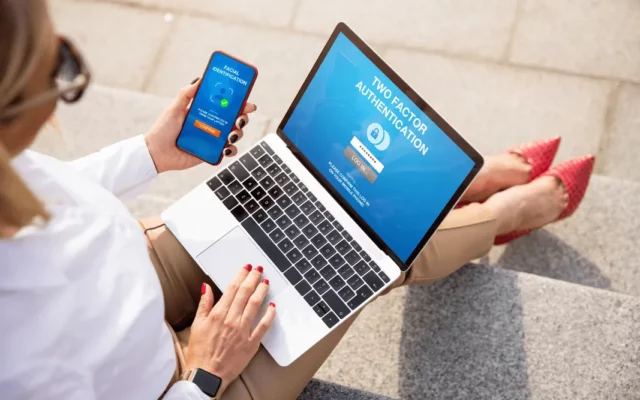
Almost every time you sign up for a service, they ask you if you would like to enable 2-factor (or in some cases multi-factor) authentication. With 86% of business leaders believing that a cataclysmic cyber-event will occur in the next two years due to geopolitical instability, it is vital to use every resource available to protect your company’s data.
Yet, according to CyberEdge’s 2022 Cyberthreat Defense Report, only 43% of companies worldwide utilize multi-factor authentication. Why?
Many cite a lack of training and minimum resources as barriers in implementing multi-factor authentication (MFA). However, including it in your organization’s software applications and profiles is not difficult. While some may see multi-factor authentication as a hindrance when accessing accounts, it actually helps your team sign into accounts more easily and combats password fatigue.
It goes without saying that multi-factor authentication can help your organization save thousands of dollars in losses due to a cyberattack or data breach. However, multi-factor authentication can also increase your overall value as an organization. According to a 2020 survey by KPMG, 87% of consumers said that data privacy is a human right. This attitude has become increasingly more evident over the past three years. Therefore, consumers will be more likely to support businesses that prioritize cybersecurity and data protection.
Multi-factor authentication is an extra safeguard when you access your profile, software, or website, as it requires you to provide various pieces of information to validate your identity. This can include your username and password, personal security questions, biometrics, one-time passwords (OTPs), and your company badge or security key.
While many people refer to multi-factor authentication and two-factor authentication (2FA) as the same thing, they are different. In general, multi-factor authentication requires two or more forms of verification, while, as the name indicates, two-factor authentication requires only two.
While 2FA does provide an increased layer of security, MFA provides the best defense against cyber attacks.
Knowledge: This includes the username and password associated with the login and personalized answers to security questions. However, with as many passwords as people must remember and because personal information is readily available online, this is not the best measure of defense.
Biometric: Biometric verification encompasses fingerprint and retina scans, facial recognition, and voice identification. In fact, your smartphone likely utilizes biometric verification.
Geographic: If you are a Microsoft 365 or Google user, you have encountered location-based verification. When you sign into your account from another device or location, you receive a notification that your account was used at this new location or through this different device. This measure helps protect organizations and companies, particularly if you have remote employees using company laptops.
OTP: This type of verification sends a one-time password (usually a string of numbers) to your phone, which you then type into your account. Due to the nature of these one-time passwords, they are generally secure. However, if a device is stolen or compromised, these OTPs can be used by a thief or hacker.
Digital Keys: Digital software can include apps that generate time-based OTPs or that require users to verify their identity by using the app to scan a barcode. This type of verification can be used at a company-wide level, as the software can be integrated with your existing platforms.
Physical Keys: Some companies and organizations require a key fob, a security card, or a USB device to access accounts. These devices can work without internet, making it one of the most secure verification methods.
Depending on the type of multi-factor authentication your organization will utilize, you can include it in your processes quickly. In fact, many apps and types of software include an option to enable security questions and OTPs—it’s merely a matter of switching it on for all of your accounts.
However, for more in-depth multi-factor authentication, such as biometric verification or digital keys, you may need to acquire an additional software or specialized services.
If you need insights on the best way to utilize multi-factor authentication in your business, Core12 can help. As Atlanta’s premier IT services company, we run penetration testing and vulnerability scanning, so we can ensure you have the right security solution to fit your needs. We’d be happy to talk with you!